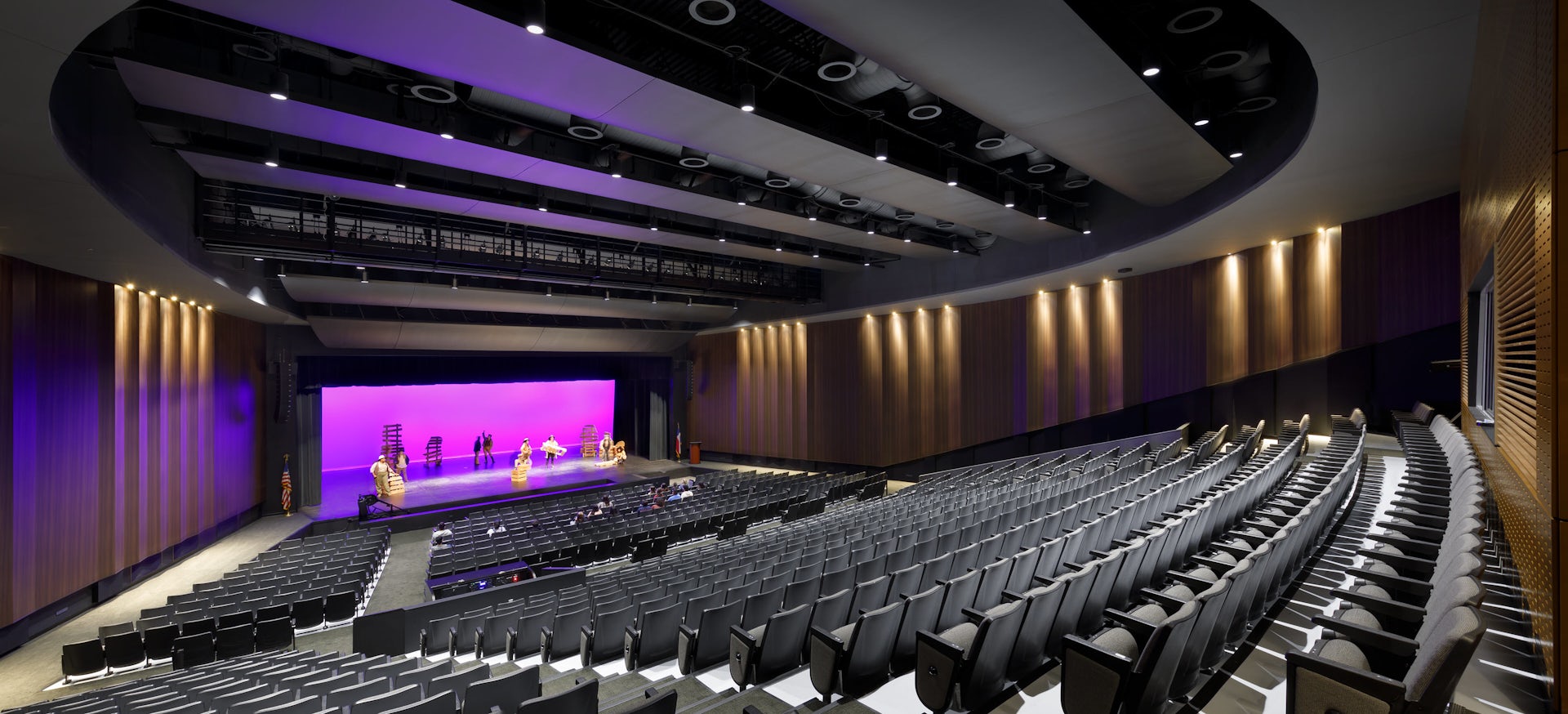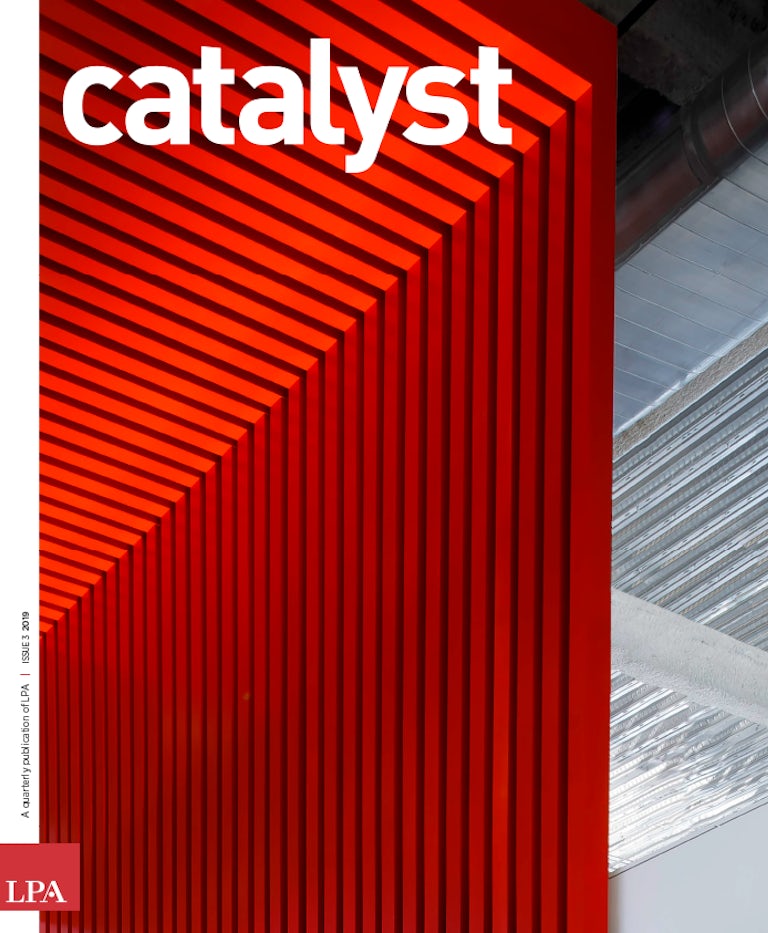For decades, Corona del Mar High School’s theater was located in a 1960s-era classroom building, which was more of a glorified lecture hall. To stage a large production like “Oklahoma!” students had to commute to another high school to borrow a bigger theater.
That all changed in 2015 when the district unveiled a 29,000-square foot, 350-seat performing arts center. Funded by a bond measure, the LPA-designed theater includes rehearsal space, a scene shop, a green room and many of the production facilities found in professional theaters. Today it serves as the heart of the campus and provides a link to the community, backed by a non-profit group focused on “enabling any student to have a rich and rewarding experience in live theater whether they are ‘backstage’ or ‘onstage.’”
Teaching Stagecraft
A new generation of high school theaters raises the bar for performance and theater arts education.

Corona del Mar’s facility is part of a new generation of high school performing arts centers that have moved far beyond “a place to put on shows.” These new high school theaters are designed as smaller versions of their professional counterparts, offering students hands-on, high-level training in theater production. Theaters have been reimagined to serve as the focus of campuses, creating connections with the community and parents, as well as students.
“The bar is definitely higher for high school theaters these days because they are also community venues,” says LPA Project Designer Emily Koch. “The school theater often becomes the place on campus where the community comes together.”
Even in a tough budget climate, administrators see the value of a vibrant theater program. Studies indicate that an arts education helps general academic achievement and develops creativity, critical thinking and collaborative skills that translate as an asset in the workplace. High school theaters also serve as important cultural institutions. The Educational Theatre Association estimates that nearly 50 million people saw a high school performance last year, comparable to the audience for Broadway touring shows and regional theater.

Opening Up
The new high school performing arts complexes embrace the larger goals of theaters, on many levels. In San Antonio, Texas, the design for the new East Central High School Performing Arts Center, which serves a dozen schools in the district, opens up the theater production process to students and the community. All the production rooms in the 37,500-square-foot building have tall windows to allow students and visitors an up-close look at the behind-the-scenes activity. The building is a teaching tool, displaying each phase along the path to a performance in sequence as a “feedback loop” around the auditorium.
“The building really embraces and exposes the production aspects—it celebrates that as much as the performance itself,” says LPA Project Architect Federico Cavazos.
In addition to a 1,000-seat auditorium with lobby and stage, the facility includes 6,800-square-feet of theater program space, 3,250-square-feet of choir space, a sound/recording room, office space and support areas for concessions, restrooms and box office. It also includes a 3,500-square-foot “white box,” a separate, long-span daylit performance and teaching space that is likely the first of its kind in a K-12 environment. East Central’s white box is a full-size replica of the main stage, with a mirrored wall that allows the performers to see what the audience will see, with acoustical isolation to allow practice and performance to overlap.
“One of the barriers to having a proper rehearsal is having adequate space at the time you need it,” says Cavazos. “We wanted to give the district a competitive advantage for theatrical competitions and allow the students to reach their full potential.”

Watch the story behind the design of East Central High School's Performing Arts Center.

New Standards
The emphasis on professional-level standards is an integral part of the mission for modern high school theaters. The facilities need to serve as training facilities that prepare students for jobs and experiences they will encounter in the profession. They also create flexibility and the ability for the theater to serve a variety of roles, including presenting productions by local and professional groups.
One key element of any professional theater is the fly loft, a space above the stage that is outfitted with a catwalk and rigging that allows stage backdrops, lighting and other equipment to be raised and lowered. Once a rarity in make-shift high school theaters, it is now seen as a priority by many designers to allow for full-scale productions, while giving students a real-world teaching opportunity.
But incorporating a fly loft is not always easy. Corona del Mar’s theater was too low to fit a traditional fly loft. In response, the architects provided the same functionality through a newer system: a horizontal fly loft in combination with a tension-grid floor of wire mesh. “It’s more flexible and provides students with the same ability to control scenery, lighting and special effects,” says LPA Project Designer Lindsay Hayward.
Older theaters present a different array of challenges. For Long Beach Polytechnic High School, a Streamline Moderne concrete theater building dating to the 1930s was completely gutted and renovated to address the school district’s educational and community goals. A balcony was demolished and replaced with 1,200 stepped stadiums seats, with scalloped walls to enhance the acoustics. Catwalks, stage rigging, lighting and professional equipment were added.
For Wilson High School in Long Beach, California, a seismic retrofit and upgraded accessibility were the main goals of a recent renovation of the campus theater, which was built in 1924. But the designers were able to add acoustic paneling, a new control room, improve the function of the catwalk and lighting, and redesign the rehearsal room, band practice space and the stage manager’s office.
“In both cases, the goal was to marry an older building with a 21st century learning environment,” says Casey Chapin, project designer in LPA’s Irvine office. “We were trying to improve the ability to use the facility as a working theater and a place to teach theater production.”

Creative Expression
Today’s high school theaters need to be designed to accommodate the demand for a wide variety of events. Any theater must have ample space to handle different functions.
“You have band, orchestra and dance, in addition to drama, who all need space but often have different-sized audiences,” says Koch. “Having a secondary performance space is a good idea, allowing schools to accommodate simultaneous productions without scheduling conflicts.”
Flexibility is essential for new theaters, maximizing the space for different types of activities, now and into the future. LPA’s design for a 500-seat high school theater currently in development calls for theater-quality seating on retractable risers that can be moved and optimized for staging and audience size. “We’re calling it a ‘flexible theater,’ since it will still have all the performance attributes of a theater, but it will be used in many ways,” Koch says.
The 1,200-seat Arcadia High School Performing Arts Center was designed by LPA to adapt its acoustics for a wide range of performances. The state-of-the-art motorized system of acoustic panels can be “tuned” to the performance. Moveable orchestra shells allow the stage to be reconfigured, depending on the number of musicians needed for the production. The facility also includes a large orchestra room with soundproof practice rooms, a black box/drama room with its own control room and flexible seating for 125 and a dance room with a specialized sprung-wood floor.
The 40,000-square-foot theater opened in 2012 with an inaugural benefit concert by music legend Paul Anka.
“We are exceptionally pleased to have realized the dream of providing our students, faculty and community members with a world class performing arts venue that will become a home for the arts in Arcadia,” AUSD Superintendent Dr. Joel Shawn told a reporter. “All aspects of the arts are an essential component of a rigorous education for our students and a healthy, vibrant community.”
This story originally appeared in Catalyst Issue 3 2019. Subscribe today to receive Catalyst, a quarterly publication that takes a deep dive into design ideas, industry leaders and initiatives.















